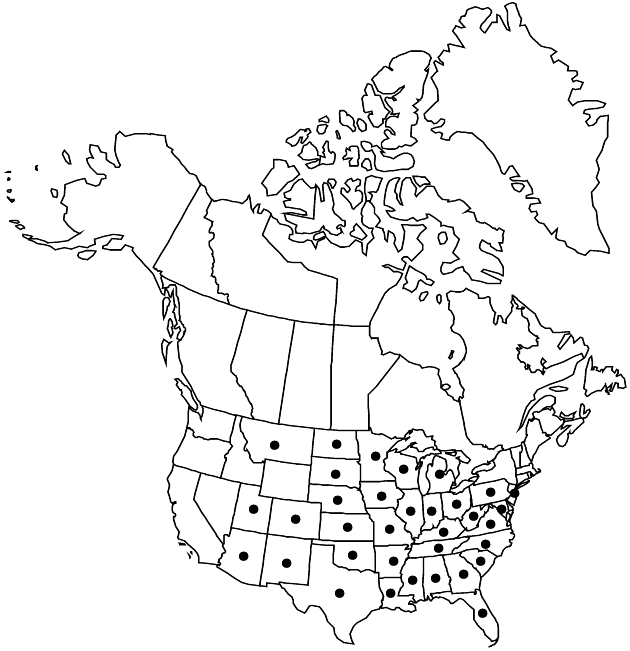Difference between revisions of "Brickellia eupatorioides"
Sida 4: 274. 1971.
FNA>Volume Importer |
RevisionBot (talk | contribs) m (Bot: Adding category Revised Since Print) |
||
| (4 intermediate revisions by 3 users not shown) | |||
| Line 6: | Line 6: | ||
|place=4: 274. 1971 | |place=4: 274. 1971 | ||
|year=1971 | |year=1971 | ||
| + | }} | ||
| + | |special_status={{Treatment/ID/Special_status | ||
| + | |code=F | ||
| + | |label=Illustrated | ||
}} | }} | ||
|basionyms={{Treatment/ID/Basionym | |basionyms={{Treatment/ID/Basionym | ||
| Line 25: | Line 29: | ||
-->{{Treatment/Body | -->{{Treatment/Body | ||
| − | |distribution= | + | |distribution=Ala.;Ariz.;Ark.;Colo.;Fla.;Ga.;Ill.;Ind.;Iowa;Kans.;Ky.;La.;Md.;Mich.;Minn.;Miss.;Mo.;Mont.;N.C.;N.Dak.;N.J.;N.Mex.;Nebr.;Ohio;Okla.;Pa.;S.C.;S.Dak.;Tenn.;Tex.;Utah;Va.;W.Va.;Wis.;Mexico. |
|discussion=<p>Varieties 6 (6 in the flora).</p> | |discussion=<p>Varieties 6 (6 in the flora).</p> | ||
|tables= | |tables= | ||
| Line 95: | Line 99: | ||
|basionyms=Kuhnia eupatorioides | |basionyms=Kuhnia eupatorioides | ||
|family=Asteraceae | |family=Asteraceae | ||
| − | |distribution= | + | |distribution=Ala.;Ariz.;Ark.;Colo.;Fla.;Ga.;Ill.;Ind.;Iowa;Kans.;Ky.;La.;Md.;Mich.;Minn.;Miss.;Mo.;Mont.;N.C.;N.Dak.;N.J.;N.Mex.;Nebr.;Ohio;Okla.;Pa.;S.C.;S.Dak.;Tenn.;Tex.;Utah;Va.;W.Va.;Wis.;Mexico. |
|reference=None | |reference=None | ||
|publication title=Sida | |publication title=Sida | ||
|publication year=1971 | |publication year=1971 | ||
| − | |special status= | + | |special status=Illustrated |
| − | |source xml=https:// | + | |source xml=https://bitbucket.org/aafc-mbb/fna-data-curation/src/2e0870ddd59836b60bcf96646a41e87ea5a5943a/coarse_grained_fna_xml/V19-20-21/V21_1255.xml |
|tribe=Asteraceae tribe Eupatorieae | |tribe=Asteraceae tribe Eupatorieae | ||
|genus=Brickellia | |genus=Brickellia | ||
| Line 106: | Line 110: | ||
}}<!-- | }}<!-- | ||
| − | -->[[Category:Treatment]][[Category:Brickellia]] | + | --> |
| + | |||
| + | [[Category:Treatment]] | ||
| + | [[Category:Brickellia]] | ||
| + | [[Category:Revised Since Print]] | ||
Latest revision as of 19:30, 6 November 2020
Perennials, 30–200 cm (bases woody). Stems branched, pubescent. Leaves mostly opposite (alternate in vars. gracillima and texana); petioles 0–10 mm; blades 1- or 3-nerved from bases, lanceolate, lance-linear, lance-ovate, lance-rhombic, linear, or oblong, 25–100 × 0.5–40 mm, bases acute, margins entire or ± dentate (often revolute), apices obtuse to acuminate, faces glandular-pubescent. Heads in paniculiform or corymbiform arrays. Peduncles 5–100 mm, glandular-pubescent. Involucres cylindric to narrowly campanulate, 7–15 mm. Phyllaries 22–26 in 4–6 series, green to stramineous, sometimes purple-tinged, 3–7-striate, unequal, margins scarious (often ciliate); outer ovate to lance-ovate (puberulent, often densely gland-dotted, apices acute to acuminate), inner lanceolate (± gland-dotted, apices obtuse to aristate). Florets 6–35; corollas pale yellow, yellow-green, pinkish lavender, or maroon, 4.5–6 mm. Cypselae 2.7–5.5 mm, glabrous or strigose, sometimes hispidulous or velutinous and/or gland-dotted; pappi of 20–28 white or tawny, usually plumose or subplumose, sometimes barbellate, bristles.
Distribution

Ala., Ariz., Ark., Colo., Fla., Ga., Ill., Ind., Iowa, Kans., Ky., La., Md., Mich., Minn., Miss., Mo., Mont., N.C., N.Dak., N.J., N.Mex., Nebr., Ohio, Okla., Pa., S.C., S.Dak., Tenn., Tex., Utah, Va., W.Va., Wis., Mexico.
Discussion
Varieties 6 (6 in the flora).
Selected References
None.
Lower Taxa
Key
| 1 | Leaf blades lance-linear or linear, 0.5–3 mm wide | > 2 |
| 1 | Leaf blades lanceolate, lance-linear, lance-ovate, or lance-rhombic, 1–40 mm wide | > 4 |
| 2 | Florets 9–13 | Brickellia eupatorioides var. floridana |
| 2 | Florets 16–30 | > 3 |
| 3 | Leaf blades 1–3 mm wide (lengths of proximal leaves greater than distals); involucres 8–13 mm | Brickellia eupatorioides var. chlorolepis |
| 3 | Leaf blades 0.5–1 mm wide (lengths of proximal leaves equaling distals); involucres 5–10 mm | Brickellia eupatorioides var. gracillima |
| 4 | Phyllaries: lengths of outers and mids 1/2–1 times inners, apices long-acuminate, usuallycontorted | Brickellia eupatorioides var. texana |
| 4 | Phyllaries: lengths of outers and mids to 1/2 times inners, apices obtuse, acute, or acuminate, not contorted | > 5 |
| 5 | Leaves 1-nerved from bases; petioles 0–1 mm; heads borne singly or 2–3 in loose, paniculiform arrays | Brickellia eupatorioides var. chlorolepis |
| 5 | Leaves 1- or 3-nerved from bases; petioles 0–10 mm; heads mostly 3–8 in dense, corymbiform arrays. | > 6 |
| 6 | Involucres 7–11 mm; florets 6–15 | Brickellia eupatorioides var. eupatorioides |
| 6 | Involucres 8–15 mm; florets 15–35 | Brickellia eupatorioides var. corymbulosa |